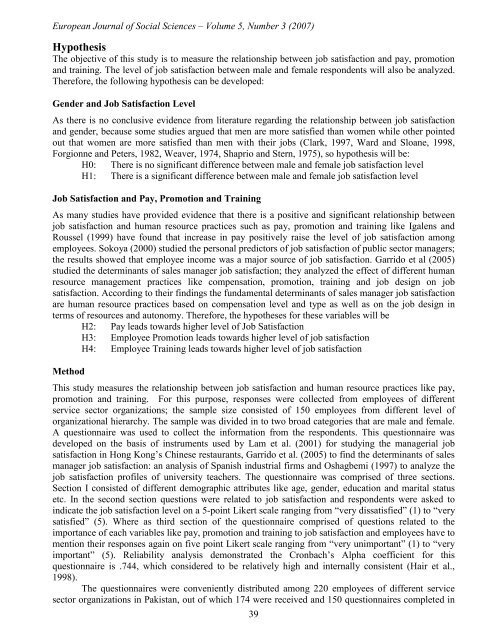european journal of social sciences issn: 1450-2267 - EuroJournals
european journal of social sciences issn: 1450-2267 - EuroJournals
european journal of social sciences issn: 1450-2267 - EuroJournals
You also want an ePaper? Increase the reach of your titles
YUMPU automatically turns print PDFs into web optimized ePapers that Google loves.
European Journal <strong>of</strong> Social Sciences – Volume 5, Number 3 (2007)<br />
Hypothesis<br />
The objective <strong>of</strong> this study is to measure the relationship between job satisfaction and pay, promotion<br />
and training. The level <strong>of</strong> job satisfaction between male and female respondents will also be analyzed.<br />
Therefore, the following hypothesis can be developed:<br />
Gender and Job Satisfaction Level<br />
As there is no conclusive evidence from literature regarding the relationship between job satisfaction<br />
and gender, because some studies argued that men are more satisfied than women while other pointed<br />
out that women are more satisfied than men with their jobs (Clark, 1997, Ward and Sloane, 1998,<br />
Forgionne and Peters, 1982, Weaver, 1974, Shaprio and Stern, 1975), so hypothesis will be:<br />
H0: There is no significant difference between male and female job satisfaction level<br />
H1: There is a significant difference between male and female job satisfaction level<br />
Job Satisfaction and Pay, Promotion and Training<br />
As many studies have provided evidence that there is a positive and significant relationship between<br />
job satisfaction and human resource practices such as pay, promotion and training like Igalens and<br />
Roussel (1999) have found that increase in pay positively raise the level <strong>of</strong> job satisfaction among<br />
employees. Sokoya (2000) studied the personal predictors <strong>of</strong> job satisfaction <strong>of</strong> public sector managers;<br />
the results showed that employee income was a major source <strong>of</strong> job satisfaction. Garrido et al (2005)<br />
studied the determinants <strong>of</strong> sales manager job satisfaction; they analyzed the effect <strong>of</strong> different human<br />
resource management practices like compensation, promotion, training and job design on job<br />
satisfaction. According to their findings the fundamental determinants <strong>of</strong> sales manager job satisfaction<br />
are human resource practices based on compensation level and type as well as on the job design in<br />
terms <strong>of</strong> resources and autonomy. Therefore, the hypotheses for these variables will be<br />
H2: Pay leads towards higher level <strong>of</strong> Job Satisfaction<br />
H3: Employee Promotion leads towards higher level <strong>of</strong> job satisfaction<br />
H4: Employee Training leads towards higher level <strong>of</strong> job satisfaction<br />
Method<br />
This study measures the relationship between job satisfaction and human resource practices like pay,<br />
promotion and training. For this purpose, responses were collected from employees <strong>of</strong> different<br />
service sector organizations; the sample size consisted <strong>of</strong> 150 employees from different level <strong>of</strong><br />
organizational hierarchy. The sample was divided in to two broad categories that are male and female.<br />
A questionnaire was used to collect the information from the respondents. This questionnaire was<br />
developed on the basis <strong>of</strong> instruments used by Lam et al. (2001) for studying the managerial job<br />
satisfaction in Hong Kong’s Chinese restaurants, Garrido et al. (2005) to find the determinants <strong>of</strong> sales<br />
manager job satisfaction: an analysis <strong>of</strong> Spanish industrial firms and Oshagbemi (1997) to analyze the<br />
job satisfaction pr<strong>of</strong>iles <strong>of</strong> university teachers. The questionnaire was comprised <strong>of</strong> three sections.<br />
Section I consisted <strong>of</strong> different demographic attributes like age, gender, education and marital status<br />
etc. In the second section questions were related to job satisfaction and respondents were asked to<br />
indicate the job satisfaction level on a 5-point Likert scale ranging from “very dissatisfied” (1) to “very<br />
satisfied” (5). Where as third section <strong>of</strong> the questionnaire comprised <strong>of</strong> questions related to the<br />
importance <strong>of</strong> each variables like pay, promotion and training to job satisfaction and employees have to<br />
mention their responses again on five point Likert scale ranging from “very unimportant” (1) to “very<br />
important” (5). Reliability analysis demonstrated the Cronbach’s Alpha coefficient for this<br />
questionnaire is .744, which considered to be relatively high and internally consistent (Hair et al.,<br />
1998).<br />
The questionnaires were conveniently distributed among 220 employees <strong>of</strong> different service<br />
sector organizations in Pakistan, out <strong>of</strong> which 174 were received and 150 questionnaires completed in<br />
39

















